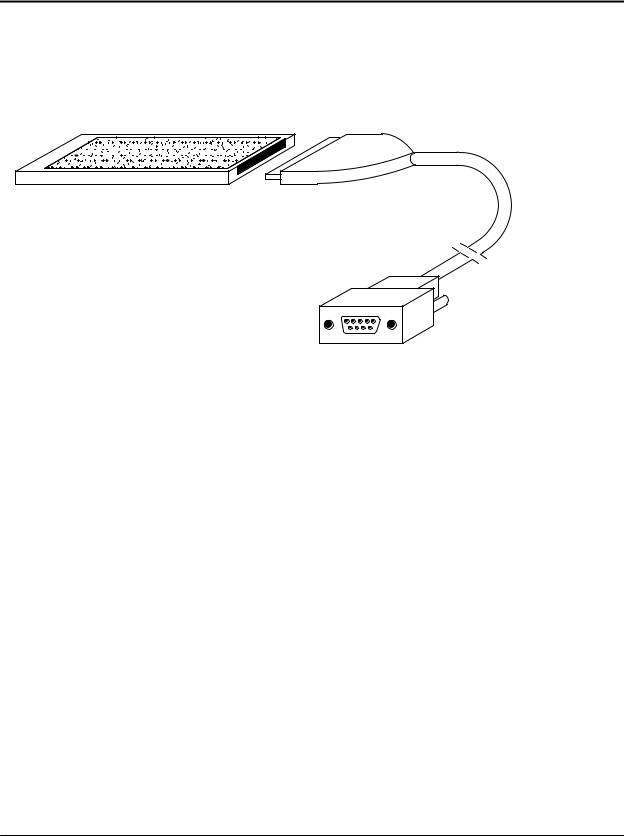Quatech SSP-100 User Manual

|
SSP-100 |
Single Channel RS-232 PCMCIA |
|
Asynchronous Adapter |
|
for PCMCIA Card Standard compatible machines |
|
User's Manual |
|
INTERFACE CARDS FOR IBM PC/AT AND PS/2 |
|
QUATECH, INC. |
TEL: (330) 434-3154 |
662 Wolf Ledges Parkway |
FAX: (330) 434-1409 |
Akron, Ohio 44311 |
BBS: (330) 434-2481 |

SSP-100 User's Manual |
i |

Warranty Information
Quatech Inc. warrants the SSP-100 to be free of defects for five (5) years from the
date of purchase. Quatech Inc. will repair or replace any adapter that fails to perform under normal operating conditions and in accordance with the procedures outlined in this document during the warranty period. Any damage that results from improper installation, operation, or general misuse voids all warranty rights.
The authors have taken due care in the preparation of this document and any associated software program(s). In no event will Quatech Inc. be liable for damages of any kind, incidental or consequential, in regard to or arising out of the performance or form of the materials presented herein and in the program(s) accompanying this document. No representation is made regarding the suitability of this product for any particular purpose.
Quatech Inc. reserves the right to edit or append to this document or the product(s) to which it refers at any time and without notice.
Please complete the following information and retain for your records. Have this information available when requesting warranty service.
Date of purchase: |
|
|
|
|
Model Number: |
SSP-100 |
|
|
|
Product Description: |
Single Channel Asynchronous RS-232 |
|
|
|
|
Communications PCMCIA Adapter |
|
|
|
Serial Number: |
|
|
|
|
SSP-200/300 User's Manual |
2 |

Declaration of Conformity
Manufacturer's Name:
Manufacturer's Address:
Application of Council Directive:
Standards to which
Conformity is Declared:
Type of Equipment:
Equipment Class:
Quatech, Inc.
662 Wolf Ledges Parkway
Akron, OH 44311 (USA)
89/336/EEC
*EN50081-1 (EN55022)
*EN50082-1
(IEC 801-2, IEC 801-3, & IEC 801-4)
Information Technology Equipment
Commercial, Residential, & Light
Industrial
Product Name: |
PCMCIA Card |
Model Number : |
SSP-100 |
SSP-200/300 User's Manual |
3 |

Table of Contents
1 |
. Introduction . . . . . . . . . . . . . . . . . . . . . . . . . . . . . . . . . . . . . . . . . . . . . . . . . . . . . . |
. 1-1 |
2 |
. DOS / Windows 3.x Installation . . . . . . . . . . . . . . . . . . . . . . . . . . . . . . . . |
2-1 |
|
2.1 SSP-100 Client Driver for DOS . . . . . . . . . . . . . . . . . . . . . . . . . . . . . . . . . . . . . . . . . |
2-2 |
|
2.1.1 Client Driver Installation . . . . . . . . . . . . . . . . . . . . . . . . . . . . . . . . . . . . . . . . . |
2-2 |
|
2.1.2 Command Line Options . . . . . . . . . . . . . . . . . . . . . . . . . . . . . . . . . . . . . . . . . |
2-3 |
|
2.1.3 Common Problems . . . . . . . . . . . . . . . . . . . . . . . . . . . . . . . . . . . . . . . . . . . . . . |
2-7 |
|
2.2 SSP-100 Enabler for DOS . . . . . . . . . . . . . . . . . . . . . . . . . . . . . . . . . . . . . . . . . . . . . . |
2-8 |
|
2.2.1 Command Line Options . . . . . . . . . . . . . . . . . . . . . . . . . . . . . . . . . . . . . . . . . |
2-9 |
|
2.2.2 Common Problems . . . . . . . . . . . . . . . . . . . . . . . . . . . . . . . . . . . . . . . . . . . . . |
2-13 |
3 |
. Windows 95, 98, 2000, ME, NT Installation . . . . . . . . . . . . . . . . . . . . |
3-1 |
|
3.1 Installing a SSP-100 Under Windows 95, 98, ME, 2000. . . . . . . . . . . . . . . . . . . . . 3-1 |
|
|
3.2 SSP-100 Resource Settings in Windows . . . . . . . . . . . . . . . . . . . . . . . . . . . . . . . . . |
3-4 |
|
3.2.1 Viewing Resource Settings with Device Manager . . . . . . . . . . . . . . . . . . . . |
3-4 |
|
3.2.2 Changing Resource Settings with Windows 95, 98, ME Device |
|
|
Manager . . . . . . . . . . . . . . . . . . . . . . . . . . . . . . . . . . . . . . . . . . . . . . . . . . . . . . . . . . . . |
3-6 |
|
3.2.3 Changing Resource Setting with Window 2000 Device Manager . . . . . . . |
3-7 |
|
3.3 Common Problems . . . . . . . . . . . . . . . . . . . . . . . . . . . . . . . . . . . . . . . . . . . . . . . . . |
3-11 |
|
3.4 Installing SSP-100 under Windows NT . . . . . . . . . . . . . . . . . . . . . . . . . . . . . . . . |
3-12 |
4 |
. Windows CE . . . . . . . . . . . . . . . . . . . . . . . . . . . . . . . . . . . . . . . . . . . . . . . . . . . . . . . |
4-1 |
5 |
OS/2 Installation . . . . . . . . . . . . . . . . . . . . . . . . . . . . . . . . . . . . . . . . . . . . . . . . . . . |
4-4 |
|
5.1 Command Line Options . . . . . . . . . . . . . . . . . . . . . . . . . . . . . . . . . . . . . . . . . . . . . . |
4-5 |
|
5.1.1 Configuring With "System Assigned" Resources . . . . . . . . . . . . . . . . . . . . |
4-5 |
|
5.1.2 Configuring With "User Assigned" Resources . . . . . . . . . . . . . . . . . . . . . . . |
4-5 |
|
5.1.3 Advanced Configuration Topics . . . . . . . . . . . . . . . . . . . . . . . . . . . . . . . . . . |
4-7 |
|
5.2 Monitoring The Status Of PCMCIA Cards . . . . . . . . . . . . . . . . . . . . . . . . . . . . . . . |
4-8 |
6 |
. External Connections . . . . . . . . . . . . . . . . . . . . . . . . . . . . . . . . . . . . . . . . . . . . . |
5-1 |
7 |
. Specifications . . . . . . . . . . . . . . . . . . . . . . . . . . . . . . . . . . . . . . . . . . . . . . . . . . . . . . |
6-1 |
SSP-200/300 User's Manual |
4 |

SSP-200/300 User's Manual |
5 |

1. Introduction
The SSP-100 is a single channel RS-232 asynchronous serial adapter for systems equipped with PCMCIA Type II and/or Type III expansion sockets. The SSP-100 is a PCMCIA Type II (5 mm) card and is PCMCIA PC Card Standard Specification 2.1 compliant.
PCMCIA Card |
Cable Assembly |
Standard D-9 Male
Figure 1. SSP-100 Card and Cable Assembly
The SSP-100 unit's serial port is implemented using a 16C550 Universal Asynchronous Receiver/Transmitter (UART), which is the recommended communications interface for multitasking environments and with applications involving high data transfer rates.
SSP-100 User's Manual |
1-1 |

(This page intentionally left blank.)
SSP-100 User's Manual |
1-2 |

2. DOS / Windows 3.x Installation
Two configuration software programs are provided with the SSP-100: a Client Driver, and a card Enabler. Both of these programs are executed from DOS (before entering Windows) and allow operation of the SSP-100 in both the DOS and Windows 3.x environments. For optimal operation, however, the Client Driver is the preferred method of installation and configuration. The table below highlights the differences between these programs.
Client Driver (recommended) |
Enabler (not recommended) |
File type: DOS device driver |
File type: DOS executable |
Interfaces to PCMCIA Card and Socket |
Interfaces directly to Intel 82365SL and |
Services software (PCMCIA host |
other PCIC compatible PCMCIA host |
adapter independent) |
adapters |
|
|
Allows automatic configuration of |
Does not support automatic |
SSP-100 adapters upon insertion (Hot |
configuration of adapters upon |
Swapping) |
insertion (Hot Swapping) |
|
|
Requires PCMCIA Card and Socket |
Does not require PCMCIA Card and |
Services software |
Socket Services software |
Figure 2. Client Driver versus Enabler for DOS/Windows 3.x.
Card and Socket Services software is commercially available from several vendors for most desktop and laptop PCs. If you are unsure whether Card and Socket Services software is currently installed on your system, install the SSP-100 Client Driver as discussed in following section. When loaded, the Client Driver will display an error message if Card and Socket Services software is not detected.
SSP-100 User’s Manual |
2-1 |

2.1 SSP-100 Client Driver for DOS
In order to use the SSP-100 Client Driver, the system must be configured with Card and Socket Services software. Card and Socket Services software is not provided with the SSP-100 but is available from Quatech.
IMPORTANT:
Some versions of Card and Socket Services dated before 1993 do not support general purpose I/O cards. If after careful installation of the Client Driver the adapter does not configure or operate properly, an updated version of Card and Socket Services may be required.
2.1.1 Client Driver Installation
The following procedure is used to install the SSP-100 Client Driver:
1.Copy the Client Driver from the SSP-100 distribution diskette onto the system's hard drive.
2.Using an ASCII text editor, open the system's CONFIG.SYS file located in the root directory of the boot drive.
3.Locate the line(s) in the CONFIG.SYS file where the Card and Socket Services software is installed.
4. AFTER the line(s) installing the Card and Socket Services software, add the
following line to the CONFIG.SYS file: |
DEVICE = drive:\path\ |
|
SSP100CL.SYS options |
where options are the SSP-100 Client Driver |
|
command line options discussed on the following pages.
5.Save the CONFIG.SYS file and exit the text editor.
6.Insert the SSP-100 into one of the system's PCMCIA slots.
NOTE: Since the SSP-100 Client Driver supports "Hot Swapping", it is not necessary to have the SSP-100 installed when booting the system. By inserting the card before booting, however, the Client Driver will report the adapter configuration during the boot process thereby verifying the changes made to the CONFIG.SYS.
7.Reboot the system and note the message displayed when the SSP-100 Client Driver is loaded. If the Client Driver reports an "invalid command line option", correct the entry in the CONFIG.SYS file and reboot the system again. If the Client Driver reports "Card and Socket Services not found", a
SSP-100 User’s Manual |
2-2 |

version of Card and Socket Services must be installed on the system or the SSP-100 Enabler program must be used to configure the adapter. If the Client Driver reports the desired adapter configuration, the installation process is complete and the SSP-100 may be removed and/ or inserted from the system as desired. On each insertion into the PCMCIA socket, the SSP-100 will be automatically reconfigured according to the command line options.
2.1.2 Command Line Options
The SSP-100 Client Driver accepts up to eight command line arguments from the user to determine the configuration of the SSP-100. If any arguments are provided, the Client Driver will attempt to configure any SSP-100 with the options specified in the order they are entered on the command line. Each argument must be enclosed in parenthesis and must be separated from other arguments by a space on the command line. Within each argument, any or all of the following parameters may be specified using a comma (no spaces) to separate each parameter:
Ssocket |
specifies which PCMCIA socket the SSP-100 must be inserted into for this |
|
configuration argument to be used. socket must be in the range 0 - 15. If this |
|
option is omitted, the configuration argument will apply to SSP-100 inserted |
|
into any socket |
Baddress |
specifies a the base I/O address of the SSP-100 in hexadecimal. This address |
|
must reside on an even 8-byte boundary. If this option is omitted, a base |
|
address will be assigned by Card and Socket Services. The “A” switch must |
|
not be used when using this command. |
Iirq |
specifies the interrupt level (IRQ) of the SSP-100 in decimal. irq must be one |
|
of the following values: 3, 4, 5, 7, 9, 10, 11, 12, 14, 15, or 0 if no IRQ is desired. |
|
If this option is omitted, an interrupt level will be assigned by Card and |
|
Socket Services. The “A” switch must not be used when using this |
|
command. |
Ebios |
specifies which location the configured SSP-100 will be placed in the BIOS |
|
equipment list. Valid numbers are 1-4. If this option is omitted, the SSP-100 |
|
will not appear in the BIOS equipment list. If no number is specified, the |
|
SSP-100 will be placed in the next available location in the BIOS equipment |
|
list. The “A” switch must not be used when using this command. |
Acom |
specifies which Logical COM port the SSP-100 will be configured. Valid |
|
COM port numbers would be 1-4. The BIOS Equipment list will be |
|
automatically updated, so the E command is not required when using this |
SSP-100 User’s Manual |
2-3 |

option. If no number is specified, the SSP-100 will be configured as the next available COM Port using the standard base address and IRQ settings for that COM port. If this option is omitted, the user must either specify a base address or IRQ setting for the SSP-100 or allow Card and Socket Services to select a base address and IRQ to configure the card. When the “A” command is used, the “B”, “I”, and “E” commands must not be used.
2.1.2.1 Example 1
DEVICE = C:\SSP-100\SSP100CL.SYS
In example 1, no command line arguments are specified. The Client Driver will configure a SSP-100 inserted into any socket with a base address and IRQ assigned by Card and Socket Services. The BIOS equipment list will not be updated.
2.1.2.2 Example 2
DEVICE = C:\SSP-100\SSP100CL.SYS (b290,i11)
In example 2, a single command line argument is provided. The Client Driver will attempt to configure a SSP-100 inserted into any socket with a base address of 290H and IRQ 11. The BIOS equipment list will not be updated. If address 290H or IRQ 11 is unavailable, the SSP-100 will not be configured.
2.1.2.3 Example 3
DEVICE = C:\SSP-100\SSP100CL.SYS (s0,b300,i5)
In example 3, a single command line argument is provided. The Client Driver will attempt to configure a SSP-100 inserted into socket 0 with a base address of 300H and IRQ 5. The BIOS equipment list will not be updated. If address 300H or IRQ 5 is unavailable, the SSP-100 will not be configured. In addition, if a SSP-100 is inserted into any other socket, it will not be configured.
2.1.2.4 Example 4
DEVICE = C:\SSP-100\SSP100CL.SYS (i5,b300)
In example 4, a single command line argument is provided. Because the parameter order is not significant, the Client Driver will attempt to configure a SSP-100 inserted into any socket with a base address of 300H and IRQ 5. The BIOS equipment list will not be updated. If address 300H or IRQ 5 is unavailable, the SSP-100 will not be configured.
2.1.2.5 Example 5
SSP-100 User’s Manual |
2-4 |

DEVICE = C:\SSP-100\SSP100CL.SYS (b300,i5) (i10) ( )
In example 5, three command line arguments are provided. The Client Driver will first attempt to configure a SSP-100 inserted into any socket with a base address of 300H and IRQ 5. The BIOS equipment list will not be updated. If address 300H or IRQ 5 is unavailable, the Client Driver will proceed to the second command line argument and attempt to configure the card with a base address assigned by Card and Socket Services and IRQ 10. If IRQ 10 is also unavailable, the Client Driver will proceed to the third command line argument and attempt to configure the SSP-100 with a base address and an IRQ assigned by Card and Socket Services.
2.1.2.6 Example 6
DEVICE = C:\SSP-100\SSP100CL.SYS (b300,i5) ( ) (i10)
In example 6, the three command line arguments of example 5 have been rearranged. The Client Driver will first attempt to configure a SSP-100 inserted into any socket with a base address of 300H and IRQ 5. The BIOS equipment list will not be updated. If address 300H or IRQ 5 is unavailable, the Client Driver will proceed to the second command line argument and attempt to configure the card with a base address and IRQ assigned by Card and Socket Services. Since the second command line argument includes all available address and IRQ resources, the third command line argument will never be reached by the Client Driver. It is the user's responsibility to place the command line arguments in a logical order.
SSP-100 User’s Manual |
2-5 |

2.1.2.7 Example 7
DEVICE = C:\SSP-100\SSP100CL.SYS (s0,b300,i5) (s1,b340,i10)
The type of configuration shown in example 7 may be desirable in systems where more than one SSP-100 is to be installed. In this example, the Client Driver will attempt to configure a SSP-100 inserted into socket 0 with a base address of 300H and IRQ 5. If the SSP-100 is inserted into socket 1, the Client Driver will attempt to configure it with base address 340H and IRQ 10. This allows the user to force the SSP-100's address and IRQ settings to be socket specific which may simplify cable connections and software development. As in the previous examples, however, if the requested address or interrupt resources are not available, the SSP-100 will not be configured.
2.1.2.8 Example 8
DEVICE=C:\SSP-100\SSP100CL.SYS (s0,b300,i5,e3)
In Example 8, the Client Driver will attempt to configure an SSP-100 into socket 0 with a base address of 300H and IRQ 5. The COM 3 spot of the BIOS Equipment list will be occupied with the SSP-100. If the requested socket, base address or interrupt resources are not available, the SSP-100 will not be configured and no update of the equipment list will take place. If the requested spot in the BIOS equipment list is not available, but the requested socket, base address, and IRQ are available, the SSP-100 will be configured but an error message will appear stating that no update of the equipment list can take place.
2.1.2.9 Example 9
DEVICE=C:\SSP-100\SSP100CL.SYS (s0,a3)
In Example 9, the Client Driver will attempt to configure an SSP-100 into socket 0 with the COM 3 standard address of 3E8H and IRQ 4. The COM 3 spot of the BIOS equipment list will be updated automatically. If the requested socket is unavailable, or the COM 3 resource settings are unavailable, the SSP-100 will not be configured and no update of the BIOS equipment list will be made. If the requested spot in the BIOS equipment list is not available, but the requested socket, base address, and IRQ are available, the SSP-100 will be configured but an error message will appear stating that no update of the equipment list can take place.
SSP-100 User’s Manual |
2-6 |

2.1.3 Common Problems
Generic Client Drivers:
Many Card and Socket Services packages include a generic client driver (or SuperClient) which configures standard I/O devices. If one of these generic client drivers is installed, it may configure the SSP-100 causing the SSP-100 client driver to fail installation. In these cases, the user should do one of the following:
1.modify the operation of the generic client driver to disable the configuration of modem/serial port cards. Consult the Card and Socket Services documentation for availability and details of this feature.
2.place the SSP-100 client driver before the generic client driver in the CONFIG.SYS.
Available Resources:
One function of the Card and Socket Services software is to track which system resources (memory addresses, I/O addresses, IRQs, etc.) are available for assignment to inserted PCMCIA cards. Sometimes, however, the Card Services software assumes or incorrectly determines that a particular resource is used when it is actually available. Most Card and Socket Services generate a resource table in a file (typically in the form of an .INI file) which the user can modify to adjust the available system resources. Consult the Card and Socket Services documentation for availability and details of this feature.
Multiple Configuration Attempts:
Some Card and Socket Services have a setting which aborts the configuration process after a single configuration failure (such as a request for an unavailable resource). The user should change this setting to allow for multiple configuration attempts. Consult the Card and Socket Services documentation for availability and details of this feature.
Older Versions of Card and Socket Services:
Some versions of Card and Socket Services dated before 1993 do not support general purpose I/O cards. If after careful installation of the Client Driver the SSP-100 does not configure or operate properly, an updated version of Card and Socket Services may be required. Card and Socket Services software is available from Quatech.
SSP-100 User’s Manual |
2-7 |
